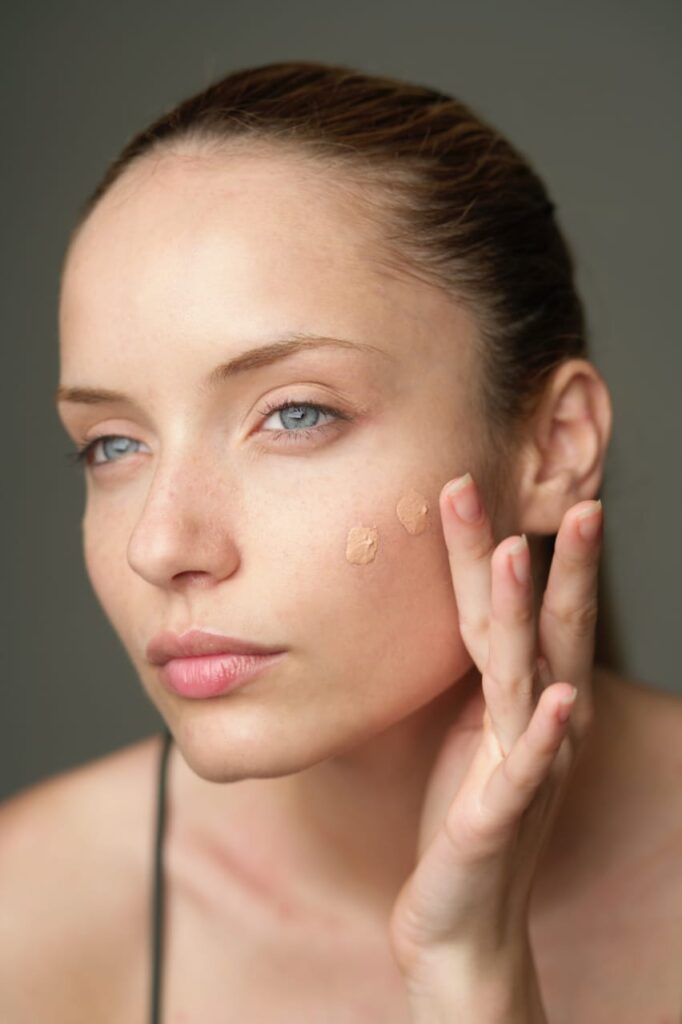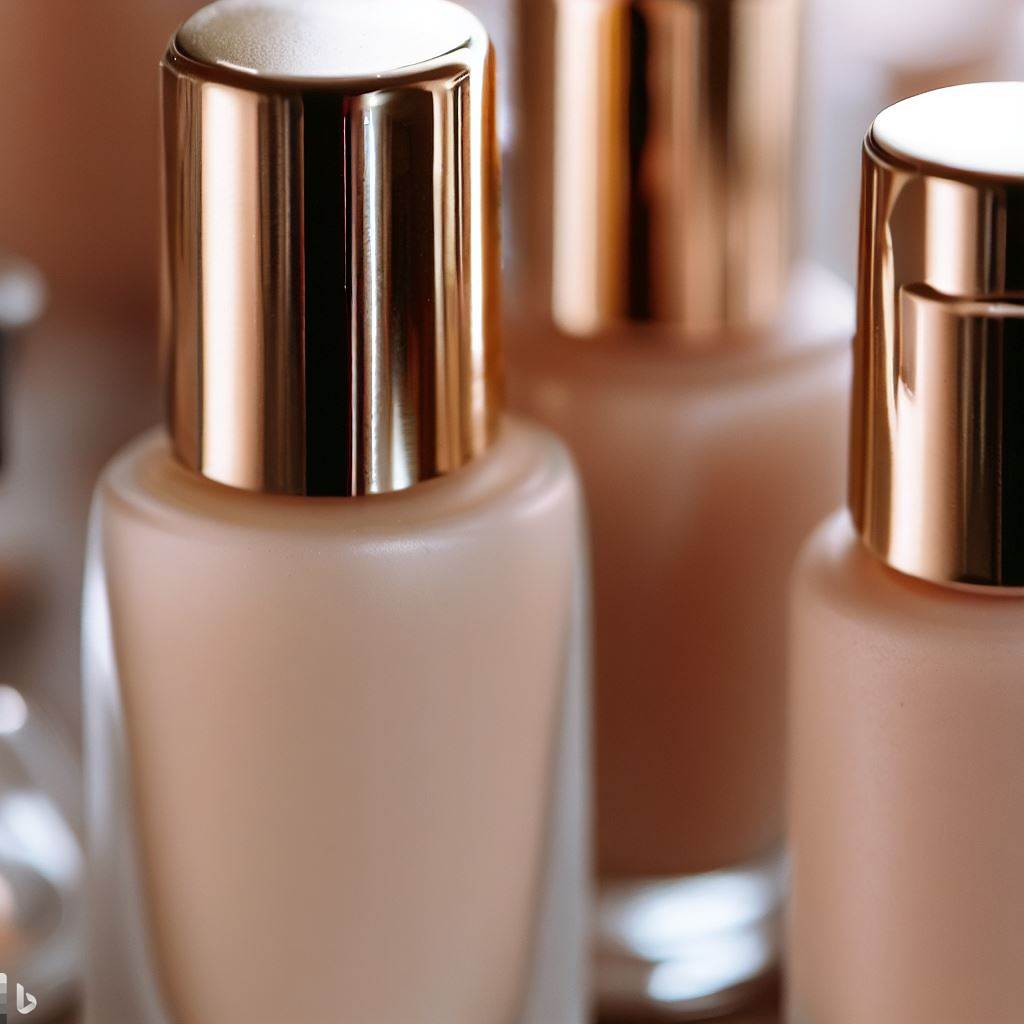Understanding Your Skin Type When choosing makeup foundation
“Discover the secret to flawless beauty with our ultimate guide to makeup foundations. From choosing the perfect shade for your skin tone to mastering application techniques, dive into the world of foundations that enhance your natural glow. Whether you prefer a radiant finish or matte perfection, our expert tips and recommendations will help you achieve a picture-perfect complexion.”
Before choosing your makeup foundations, identify whether your skin is oily, dry, combination, or sensitive. This knowledge will guide you towards the formulations that will suit your skin’s unique needs.
Undertone Insights:
Check your undertone – cool, warm, or neutral – to ensure that the foundation shade you choose harmonizes with your natural skin tone, enhancing your overall complexion.
Patch Test Perfection:
Always perform a patch test to ensure the foundation doesn’t cause irritation or allergic reactions. Apply a small amount on your jawline or wrist and observe for any adverse effects.
Consult the Experts:
Visit a beauty counter or makeup specialist to get color-matched and gather recommendations based on your skin type and desired finish.
The Formula Factor:
Consider your preferred formula – liquid, powder, cream, or stick. Different formulas offer various levels of coverage and finish, catering to diverse makeup preferences.
Coverage Choices:
Determine the level of coverage you need – sheer, medium, or full. This decision depends on your personal preferences and any specific imperfections you want to address.
Testing in Natural Light:
Always swatch and test foundation shades in natural light. This environment provides the most accurate representation of how the foundation will appear on your skin throughout the day.
Bendability Matters:
Opt for a foundation that’s easy to blend, as this ensures a seamless transition between your natural skin and the makeup for a more natural look.
Longevity and Wear:
Consider the longevity you require from your foundation. If you need it to last all day, choose a long-wearing formula that can withstand various activities.
Ingredient Awareness:
Take a glance at the ingredient list to ensure the foundation is free from any components that might trigger allergies or sensitivities.
Customizable Finish:
Look for foundations that allow you to customize your finish – whether you prefer a matte, dewy, or satin look, the right foundation can help you achieve it.
Buildable Application:
Opt for a foundation that can be built up in layers. This allows you to achieve different levels of coverage without the risk of cakey or heavy-looking makeup.
Consider Special Concerns:
If you have specific skin concerns such as acne, fine lines, or large pores, look for foundations that are formulated to address those issues.
Invest in Primer:
Pair your foundation with a suitable primer to create a smooth canvas, enhance its longevity, and improve its overall performance.
Check for SPF:
Some foundations offer added sun protection. If sun protection is important to you, consider opting for a foundation with built-in SPF.
Remember, finding the ideal makeup foundation is a journey that involves trial and error. By considering these factors and taking your time to explore different options, you’ll be well on your way to achieving a flawless and radiant complexion.
Undertone Insights


Cool, Warm, or Neutral?
Knowing whether your undertone is cool, warm, or neutral is crucial since it influences the foundation colour you choose. You probably have a cool undertone if you see blue or pink undertones in your skin. Warm undertones are indicated by yellow or peachy undertones, whereas a harmony of the two suggests a neutral undertone.
Vein Examination:
Examine the veins on your wrist in the daylight. They will probably appear bluish if you have a chilly undertone. If they appear more greenish, you have a warm undertone. The inability to accurately identify the color can indicate a neutral undertone.
Jewelry Preference:
Consider whether gold or silver jewelery best suits your skin tone while choosing jewllery. People who look great in silver typically have chilly undertones, while gold jewellery brings out warm undertone.
Color Reaction:
Be careful of how different clothing colors effect your skin tone. You likely have a cool undertone if cool-toned colours like blues and purples make your skin look more lively. Your undertone is warm if colors like oranges and yellows make you look good.
Neutral Testing:
You may have a neutral undertone if it’s difficult to identify whether your personality is more towards coolness or warmth. Skin with neutral undertones typically has a perfect blend of cool and warm tones.
Foundation Swatch:
Swatch a range of foundation color with different undertones on your jawline. The color that most closely resembles your skin tone undertone may be the best choice.
Assistance with Consultation:
If you’re unsure of your undertone, speak with makeup artists or other beauty professionals who can offer specialized advice based on their knowledge.
Seasonal Changes:
Be aware that exposure to sunlight or seasonal changes may cause your undertone to gradually vary. To ensure a perfect match all year long, adjust the color of your foundation accordingly.
Building a Collection:
If you already own a foundation that perfectly matches your skin tone, think about utilizing it as a guide while trying out other items. This might assist you in making consistent color selections that flatter your skin tone.
foundation for dry skin


Choose foundations that are marketed as “hydrating” or “moisturizing.” These formulations frequently include substances that supply vital moisture to fight dryness, such as glycerin, hyaluronic acid, or oils.
Liquid Foundations:
Due to their more fluid texture and ability to create a dewy and healthy look, liquid foundations frequently work well for dry skin.
Cream-Based Foundations
Cream foundations have a thicker consistency and can provide dry skin more moisture and coverage. They can produce a nourished and radiant appearance.
Serum Foundations:
Serum foundations are a fantastic option for dry skin because they are lightweight and frequently contain moisturizing elements. They offer a brilliant, natural finish.
Avoid Matte Foundations:
Avoid matte foundations since they can highlight dry areas and give the appearance of flaky skin. Choose foundations instead that advertise a radiant or dewy look.
BB CREAMS
These creams, known as BB Creams or Tinted Moisturizers, give a lesser level of coverage while hydrating the skin and adding a dash of colour. They’re perfect for people who prefer a fresh, natural look without the weight of a complete foundation.
Mineral Foundations:
Some mineral foundations are made with nourishing components that can be kind to dry skin. Choose those that haven’t had drying agents added.
Foundations with SPF:
If you want a foundation that offers sun protection, pick one that also has moisturizing qualities. In this manner, you may hydrate and protect your skin from the sun.
Prep with Moisturizer:
Make sure your skin is well-prepared with a moisturizing moisturizer before applying foundation to guarantee a smooth base and stop the foundation from adhering to dry places.
Primer with Hyaluronic Acid:
Consider using a primer that has moisturizing elements like hyaluronic acid. By adding an additional layer of moisture, you can improve the way your foundation adheres to your skin.
Spritz of Hydrating Mist:
After applying your makeup, spray your face with moisturizing facial water to set your foundation and keep your skin looking dewy and fresh.
Buildable Coverage:
Pick a foundation that enables you to add coverage where it’s most needed without making you look clumsy. By doing this, you can treat dry regions while maintaining a natural look.
Avoid Using Too Much Powder:
Applying too much setting powder might cause the skin to become even more dry. Use them sparingly only in places that are prone to excessive shine, if necessary.
Regular Skincare Routine:
Keep in mind that a foundation has its limitations. To maintain your dry skin healthy and supple, consistently prectise a skincare routine that entails gentle cleaning, exfoliation, and lots of hydration.
The foundation that offers the appropriate coverage, moisture, and a radiant finish is ultimately the finest foundation for dry skin. Try out various options to discover the formula.
Foundation for oily skin
Matte Formulas: Search for foundations that are particularly marked as “matte” or “oil-free.” These formulae are developed to control excess oil and offer a finish that is shiny-free and smooth.
Powder foundations: These can help keep skin looking matte all day long by absorbing extra oil. On oily skin, they are especially helpful for touch-ups.
Long-Wearing Formulas: using foundations that last all day or all night. These formulations are designed to resist grease and keep their finish for a long time.
Oil-Control Primer: Before applying foundation, think about using an oil-control primer. By taking an extra step, you can assist prevent excessive oil from absorbing the foundation by creating a layer of protection between your skin and it.
Mineral foundations: Some mineral foundations have the ability to absorb oil, giving off a natural covering and reducing shine.
Water-Based Foundations: Lightweight and frequently good for oily skin, water-based foundations are easy to apply. They offer protection without becoming heavy or oily.
Avoid Foundations with Dewy or Luminous Finishes: Foundations with dewy or luminous finishes should be avoided since they might increase the appearance of oiliness on skin that is already oily.
Oil-Absorbing Ingredients: Look for foundations that have oil-absorbing elements like silica, kaolin clay, or salicylic acid. These components may help in reducing shine.
Buildable Coverage: Foundations that offer buildable coverage are the best choice. By doing this, you can apply more layers of the cream where you need more coverage without damaging your skin.
Blotting Papers: Have blotting papers on hand to absorb extra oil without removing your makeup throughout the day.
Set with Translucent Powder: To seal in your makeup and manage shine, dust on a translucent, oil-absorbing powder after applying foundation.
Avoid Heavy Creams: Avoid using heavy foundations that are based in cream because they might feel excessively thick on oily skin and make you look greasy.
Oil-Free SPF: If you’re wearing a foundation with SPF, make sure it’s oil-free to prevent your skin from producing additional oil.
Regular Cleansing Routine: Regular Cleansing: To eliminate extra oil and prevent clogged pores, which can lead to increased oiliness, regularly wash your face with a mild cleanser.
Balanced Skincare: Maintain a balanced skincare regimen that combines an oil-free, lightweight moisturizer and items made specifically for oily skin to control excessive oil production.
Foundation for normal skin


Foundations with a Natural Finish: using foundations with a natural finish. These formulations enhance your skin’s natural radiance without making it look overly oily or dry. They establish a balance between matte and dewy.
Lightweight Formulas: Choose foundations that offer coverage without leaving your skin feeling heave. Your skin’s natural texture can now be seen through.
Medium Coverage :Foundations with medium coverage are frequently the best choice for skin with typical skin. They assist in balancing skin tone while yet letting your inherent beauty shine through.
Liquid Foundations: Due to their adaptability, liquid foundations frequently perform effectively on skin that is typical in tone. They preserve a natural appearance while offering coverage.
Tinted Moisturizers: Consider using tinted moisturizers on days when you want to wear the least amount of makeup possible. These offer hydrate your skin while adding a bit of color
BB Creams: Also known as beauty balm creams, BB creams combine light coverage with skincare advantages. They’re excellent for improving the natural appearance of your skin.
Hydrating Formulas: Even if you have normal skin, a foundation with hydrating qualities will help you keep the right balance of moisture on your skin and give you a glowing appearance.
Satin or Luminous Finishes: Foundations with satin or luminous finishes can bring out your skin’s inherent radiance without making it appear too glossy.
SPF-Infused Foundations: SPF-Infused Foundations: To add an additional layer of sun protection to your everyday routine, using foundations that let you add additional protection as necessary. This allows you the freedom to alter how you look for different kinds of situations.
Options without silicone: If you’d rather stay away from silicone-based cosmetics, check for foundations that fit your needs.
Avoid Heavy formulae: Because your skin is normal, avoid heavy or highly matte formulae as they could upset the equilibrium of your skin.
Regular Skincare: Keep up a regular skincare routine to keep your skin in top shape and improve the overall impact of your makeup.
Test Foundation Shades Before Buying: Always swatch and test foundation shades before buying to make sure the color and formula match the undertones and demands of your skin.
Custom Blend: Some brands offer customizable foundation options that allow you to mix shades and adjust coverage to your liking, giving you a personalized experience.




